AP SSC or 10th Class Question Paper Mathematics Paper 1 English Medium 2018 with Solutions – Free Download
Andhra Pradesh SSC (Class 10) Maths 2018 question paper 1 with solutions are available here in a downloadable pdf format and also in the text so that the students can easily access them. Along with the solutions, they can also get the Maths question paper 1 2018 Class 10 SSC for reference. Students are able to access all the Andhra Pradesh board previous year maths question papers here. AP 10th Class Mathematics Question Paper 2018 Paper 1 can be downloaded easily and students can use them and verify the answers provided by BYJU’S. Solving 2018 Maths question paper 1 for Class 10 will help the students to predict what type of questions will appear in the exam.
Download SSC 2018 Question Paper Maths Paper 1
Download SSC 2018 Question Paper Maths Paper 1 With Solutions
Andhra Pradesh SSC Class 10th Maths Question Paper 1 With Solution 2018
QUESTION PAPER CODE 15E(A)
SECTION – I
(4 * 1 = 4)
Question 1: Find the HCF of 60 and 100 by using Euclid’s division lemma.
Solution:
Using Euclid’s division lemma –
100 = (60 × 1) + 40
60 = (40 × 1) + 20
40 = (20 × 2) + 0
The remainder is 0.
The HCF of 60 and 100 is 20.
Question 2: Write A = {3, 9, 27, 81} in set builder form.
Solution:
A = {3 , 9 , 27 , 81}
Set builder form
A = {x : x = 3n, n belongs to N & n < 5}
Question 3: Find the value of k for which the pair of equations 2x + ky + 3 = 0, 4x + 6y – 5 = 0 represent parallel lines.
Solution:
On comparing the given equations,
2x – ky + 3 = 0 ,
4x + 6y – 5 = 0 with
a1x + b1y + c1 = 0 and a2x + b2y + c2 = 0
a1 = 2 , b1 = -k , c1 = 3 ;
a2 = 4 , b2 = 6 , c2 = -5 ;
a1 / a2 = b1 / b2 ≠ c1 / c2
a1 / a2 = b1 / b2
2 / 4 = (-k) / 6
(2 × -6) / 4 = k
k = -3 or 18 / 5
Question 4: Find the volume of the right circular cone with radius 3cm and height 14cm.
Solution:
Given the radius of the cone is 3cm and height is 14cm.
The volume of the cone = (⅓) πr²h
= (1 / 3) × (22 / 7) × 3 × 3 × 14
= 22 × 3 × 2
= 132cm³
SECTION – II
(5 * 2 = 10)
Question 5: Find the zeroes of the polynomial x2 – 3 and verify the relationship between the zeroes and coefficients.
Solution:
x² – 3 = 0
x² = 3
x = ±√3
The zeroes of the given polynomial are √3 and -√3.
Relationship between the zeroes and coefficients
Sum of zeroes = √3 + (-√3) = √3 – √3 = 0 = coefficient of -x / coefficient of x²
Product of zeroes = (√3) (-√3) = -(√3)² = -3 / 1 = constant / coefficient of x²
Question 6: How many three-digit numbers are divisible by 3?
Solution:
The three-digit natural numbers start from 100 and end with 999.
The first three-digit number which is divisible by 3 is 102.
The last three-digit number which is divisible by 3 is 999.
The number of three-digit numbers divisible by 3
= 999 / 3 – (102 / 3) + 1
= 333 − 34 + 1
= 300
Question 7: A solid iron rod has a cylindrical shape. Its height is 11cm and base diameter is 7cm. Then find the total volume of 50 rods.
Solution:
The height of the cylinder is 11cm.
The diameter of the cylinder is 7cm.
The volume of cylinder = πr2h
= (22 / 7) * (7 / 2) * (7 / 2) * 11
= (121) * (7 / 2)
= 423.5
The volume of 50 such rods
= 50 × 423.5
= 21175 cm2
Question 8: Find the roots of x + (6 / x) = 7, x ≠ 0.
Solution:
x + (6 / x) = 7
x2 – 7x + 6 = 0
x2 – 6x – x + 6 = 0
x (x – 6) – 1 (x – 6) = 0
x = 1, 6
Question 9: Length of a rectangle is 2 units greater than its breadth. If the area of the rectangle is 120 square units, then find its length.
Solution:
Breadth = x
Length = x + 2
Area = 120 square units
x (x + 2) = 120
x2 + 2x = 120
x2 + 2x – 120 = 0
(x + 12)(x – 10) = 0
x = (-12), (10)
The value of x can’t be negative as it is the breadth of a rectangle.
x = 10
Breadth = 10
Length = x + 2 = 10 + 2 = 12
SECTION – III
(4 * 4 = 16)
Question 10:
[a] Hari went to a bank to withdraw Rs. 2000. He asked the cashier to give the cash in Rs. 50 and Rs. 100 separately. He got 25 notes in all. Can you tell how many notes, each of Rs. 50 and Rs. 100 he received?
OR
[b] How many spherical balls can be made out of a solid cube of lead, whose edges measure 66 cm and each ball being 3cm in radius?
Solution:
[a] Let the number of Rs. 50 notes are ‘x’.Let the number of Rs. 100 notes are ‘y’.
Total notes = 25
⇒ x + y = 25
⇒ x = 25 – y
Total amount only in Rs. 50 notes = 50x
Total amount only in Rs. 100 notes = 100y
Total amount = 2000
⇒ 50x + 100y = 2000
⇒ 50(25 – y) + 100y = 2000
⇒ 50* 25 – 50y + 100y = 2000
⇒ 1250 + 50 y = 2000
⇒ 50y = 2000 – 1250 = 750
⇒ y = 750 / 50 = 15
x = 25 – 15 = 10
The number of Rs. 50 notes = 10
The number of Rs. 100 notes = 15
[b] Radius of each ball = 3 cmLength of the edge of cube = 66 cm
The volume of each ball is given by V = (4 / 3) πr3
= (4 / 3) * (22 / 7) * (33)
= 113.14 cm3
The volume of a cube is given by a3 = 663 = 287496
So, the number of spherical balls is given by
= volume of the cube / volume of the ball
= 287496 / 113.14
= 2541
Hence, there are 2541 spherical balls that can be made.
Question 11:
[a] Show that √3 is irrational.
OR
[b] If A = {x : x is a natural number }
B = {x : x is an even number}
C = {x : x is an odd number}
D = {x : x is a prime number}
Then find A ∪ B, A ∩ C, B ∩ C and B ∩ D. What do you notice?
Solution:
[a] Assume that √3 is rational.Then, there exist positive integers a and b such that √3 = a / b, where a and b are coprime, their HCF is 1.
√3 = a / b
⇒ 3 = a2 / b2
⇒ 3b2 = a2
⇒ 3 divided a2
⇒ 3 divides a —- (1)
⇒ a = 3c for some integer c
⇒ a2 = 9c2
⇒ 3b2 = 9c2
⇒ b2 = 3c2
⇒ 3 divides b2
⇒ 3 divides b —- (2)
From (i) and (ii), it is observed that a and b have at least 3 as a common factor. But, this contradicts the fact that a and b are co-prime. This means that our assumption is not correct.
Hence, √3 is an irrational number.
[b] A ∪ B = {all natural numbers}A ∩ C = {all odd numbers}
B ∩ C = { }
B ∩ D = {2}
Question 12:
[a] The sum of the reciprocals of Rehman’s age, (in years) 3 years ago and 5 years from now is 1 / 3. Find the present age.
OR
[b] If the sum of the first 7 terms and 15 terms of an AP are 98 and 390, respectively. Find the sum of the first 10 terms.
Solution:
[a] Let the age of Rehman be x years. ————- (1)Rehman’s 3 years ago age will be x – 3. ———– (2)
Rehman’s 5 years ago age will be x + 5. ———- (3)
Given, the sum of reciprocals of (1), (2), (3) will be 1 / 3.
[1 / x – 3] + [1 / x + 5] = 1 / 3 [x + 5 + x – 3] / [(x – 3) (x + 5)] = 1 / 3 [2x + 2] / [(x – 3) (x + 5)] = 1 / 36x + 6 = x2 + 2x – 15
x2 + 2x – 15 – 6x – 6 = 0
x2 – 4x – 21 = 0
(x – 7) (x – 3) = 0
x = 7 or x = -3.
The value of x cannot be negative.
So, the present age of Rehman is 7 years.
[b]Sum = (n / 2) (2a + [n – 1]d)
98 = (7 / 2) (2a + 6d)
28 = 2a + 6d
14 = a + 3d —- (1)
390 = (15 / 2) (2a + [15 – 1] d)
52 = 2a + 14d
26 = a + 7d —- (2)
On solving the equations (1) and (2),
a = 5 and d = 3
Sum to 10 terms
= [10 / 2] * (2 * 5 + (10 – 1) * 3
= 5 (10 + 27)
= 37 * 5
= 185
Question 13:
[a] Solve the quadratic polynomial p(x) = x2 – x – 6 by graphical method.
OR
[b] The perimeter of a rectangular plot is 32m. If the length is increased by 2m and the breadth is decreased by 1m, then the area of the plot remains the same. Find the length and breadth of the plot.
Solution:
[a] y = x2 – x – 6y intercept at x = 0
y = 0 – 0 – 6 = – 6
x intercept at y = 0
x2 – x – 6 = 0
x2 – 3x + 2x – 6 = 0
x (x – 3) + 2 (x – 3) = 0
(x – 3) (x + 2) = 0
x = 3, -2
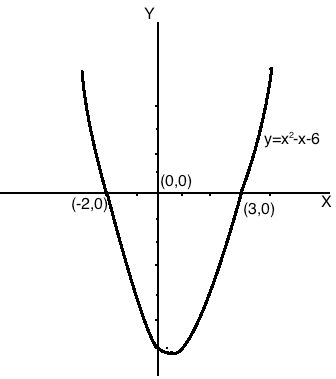
Perimeter = 32 m ( given )
2(l + b) = 32
l + b = 16 — ( 1 )
If length is increased by 2 m and the breadth is decreased by 1 m, the area of the plot remains the same .
( l + 2 ) ( b – 1 ) = lb
lb – l + 2b – 2 = lb
– l + 2b = 2 — ( 2 )
Add equations ( 1 ) and ( 2 ),
3b = 18
b = 18 /3
b = 6
Put b = 6 in equation ( 1 ),
l + b = 16
l + 6 = 16
l = 10
Therefore, length of the rectangle plot = l = 10m and breadth = b = 6 m.
SECTION – IV
(20 * 0.5 = 10)
Question 14: Which of the following is a terminating decimal?
(A) 10 / 81 (B) 41 / 75 (C) 8 / 125 (D) 3 /14
Answer: C
Question 15: The value of log2 32 is ____
(A) 2 (B) 32 (C) I / 5 (D) 5
Answer: D
Question 16: If 3 is one of the zeroes of p(x) = x2 + kx – 9, the the value of k is
(A) 0 (B) 1 (C) 2 (D) 3
Answer: A
Question 17: The pair of equations a1x + b1y + c1 = 0 and a2x + b2y + c2 = 0, are consistent, then
(A) a1 / a2 ≄ b1 / b2
(B) a1 / a2 = b1 / b2 ≄ c1 / c2
(C) a1 / a2 = b1 / b2 = c1 / c2
(D) A and C
Answer: D
Question 18: If ɑ, β, Ɣ are the zeroes of the cubic polynomial ax3 + bx2 + cx + d and (ɑ ≄ 0), then ɑβƔ is
(A) d / a (B) -d / a (C) -b / a (D) c / a
Answer: B
Question 19: Which term of an AP 18, 15, 12 … equals to 0?
(A) 4 (B) 5 (C) 6 (D) 7
Answer: D
Question 20: If A ⊂ B, n(A) = 4, n(B) = 6, then n(A ∪ B) = ___
(A) 10 (B) 6 (C) 4 (D) 2
Answer: C
Question 21: If k, 2k + 1, 2k + 3 are three consecutive terms in AP, then the value of k is
(A) 1 (B) 0 (C) 2 (D) 3
Answer: A
Question 22: A quadratic polynomial, whose zeroes are √2 and – √2 is
(A) x2 – 4 (B) x2 + 4 (C) x2 – 2 (D) x2 + 2
Answer: C
Question 23: If an = n / (n + 1), then a2017 =
(A) 2017 / 2016 (B) 2017 / 2018 (C) 2017 / 2019 (D) 2018 / 2017
Answer: B
Question 24: A cylinder and cone have bases of equal radii and are of equal heights, then their volumes are in the ratio
(A) 1:1 (B) 1:3 (C) 3:1 (D) 1:9
Answer: C
Question 25: Total surface area of a solid hemisphere of radius 7cm is _____ cm2.
(A) 21𝛑 (B) 49 𝛑 (C) 147𝛑 (D) 98𝛑
Answer: C
Question 26: A quadratic equation ax2 + bx + c = 0 has 2 distinct real roots, if
(A) b2 – 4ac > 0 (B) b2 – 4ac < 0 (C) b2 – 4ac = 0 (D) None of these
Answer: A
Question 27: The degree of the polynomial 5x7 – 6x5 + 7x – 4 is
(A) 5 (B) 6 (C) 7 (D) 4
Answer: C
Question 28: The nth term of a progression a, ar, ar2, is
(A) ar (B) ar2 (C) a + (n – 1)r (D) arn-1
Answer: D
Question 29: Which of the following equations has the solution of (1, -1)?
(A) 3x – 2y = 6 (B) 3x + 2y = 6 (C) 3x – 2y = 5 (D) 3x + 2y = 5
Answer: C
Question 30: If A = {x : x is a letter in the word EXAMINATION, then its roster form is
(A) A = {e, x, m, i, n, a, t, o, s}
(B) A = {e, x, m, i, n, a, t, o}
(C) A = {e, x, m, a, i, n, t, s}
(D) A = {e, x, m, i, n, t, o}
Answer: B
Question 31: The following Venn diagram indicates
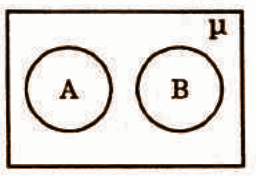
(A) A ⊂ B (B) B ⊂ A (C) A, B are disjoint sets (D) A = B
Answer: C
Question 32: The discriminant of the quadratic equation px2 + qx + r = 0 is
(A) p2 – 4qr (B) q2 – 4pr (C) q2 + 4pr (D) r2 – 4pq
Answer: B
Question 33: Number of zeroes that can be identified by the following figure.
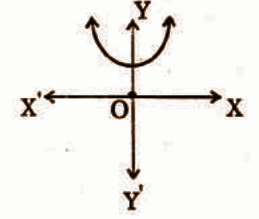
(A) 0 (B) 1 (C) 2 (D) 3
Answer: A


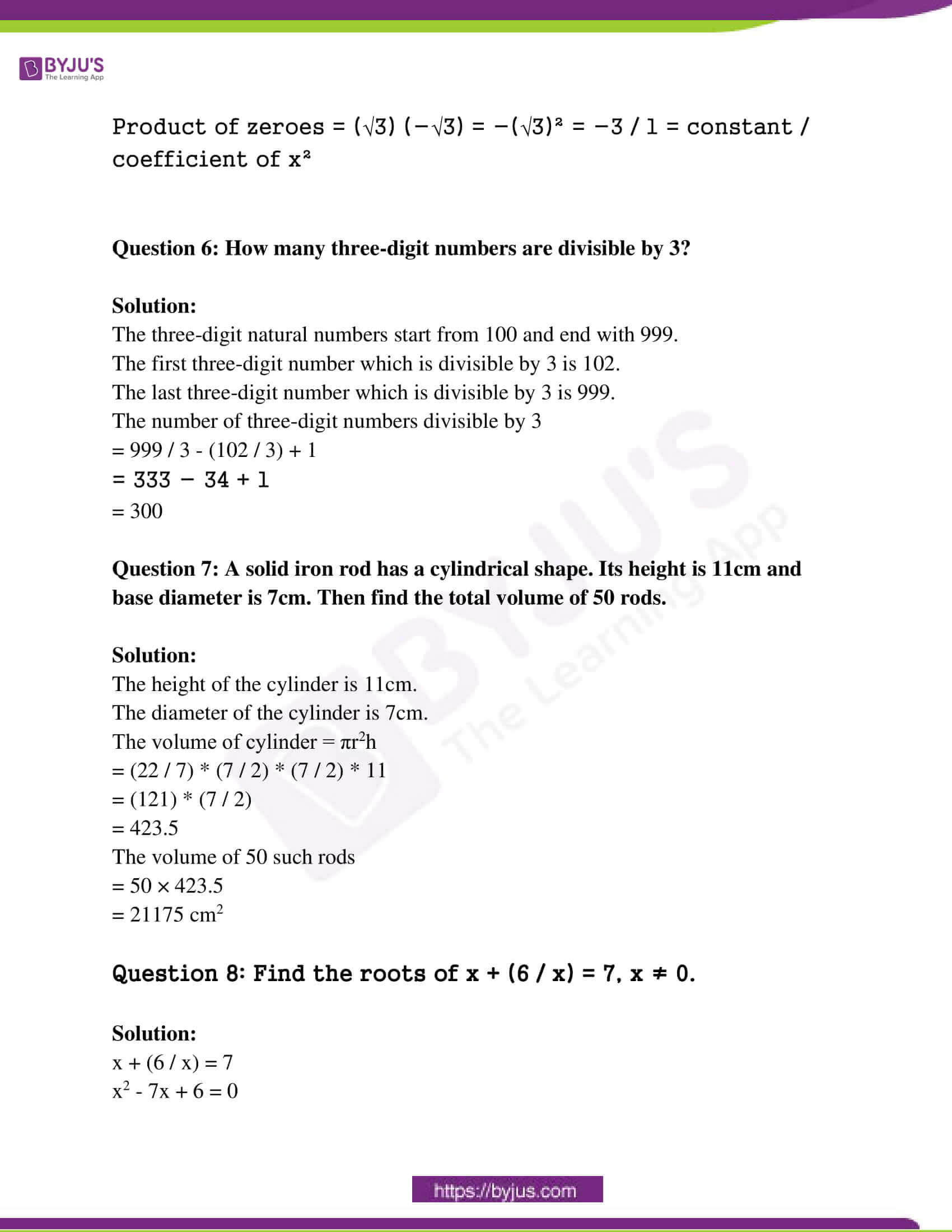

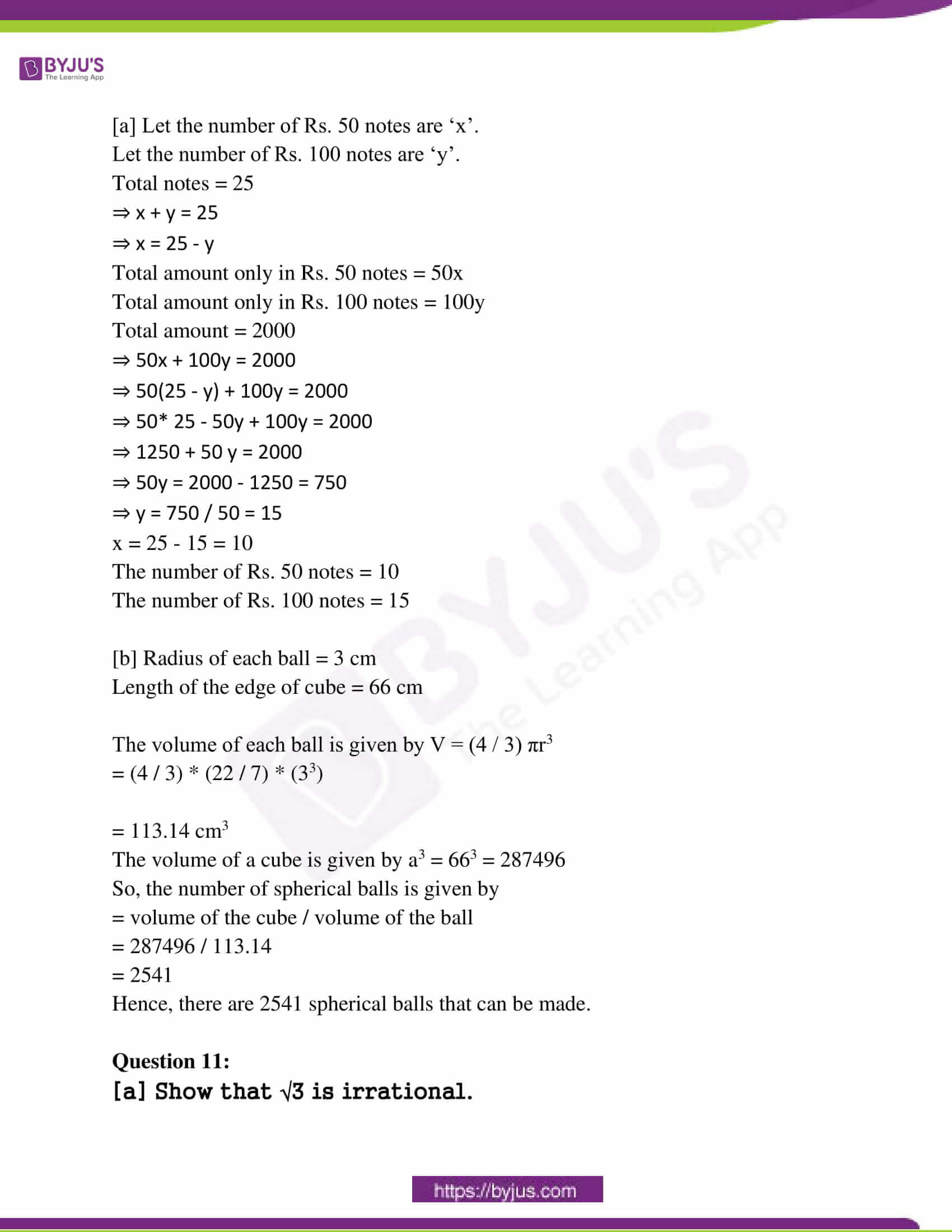
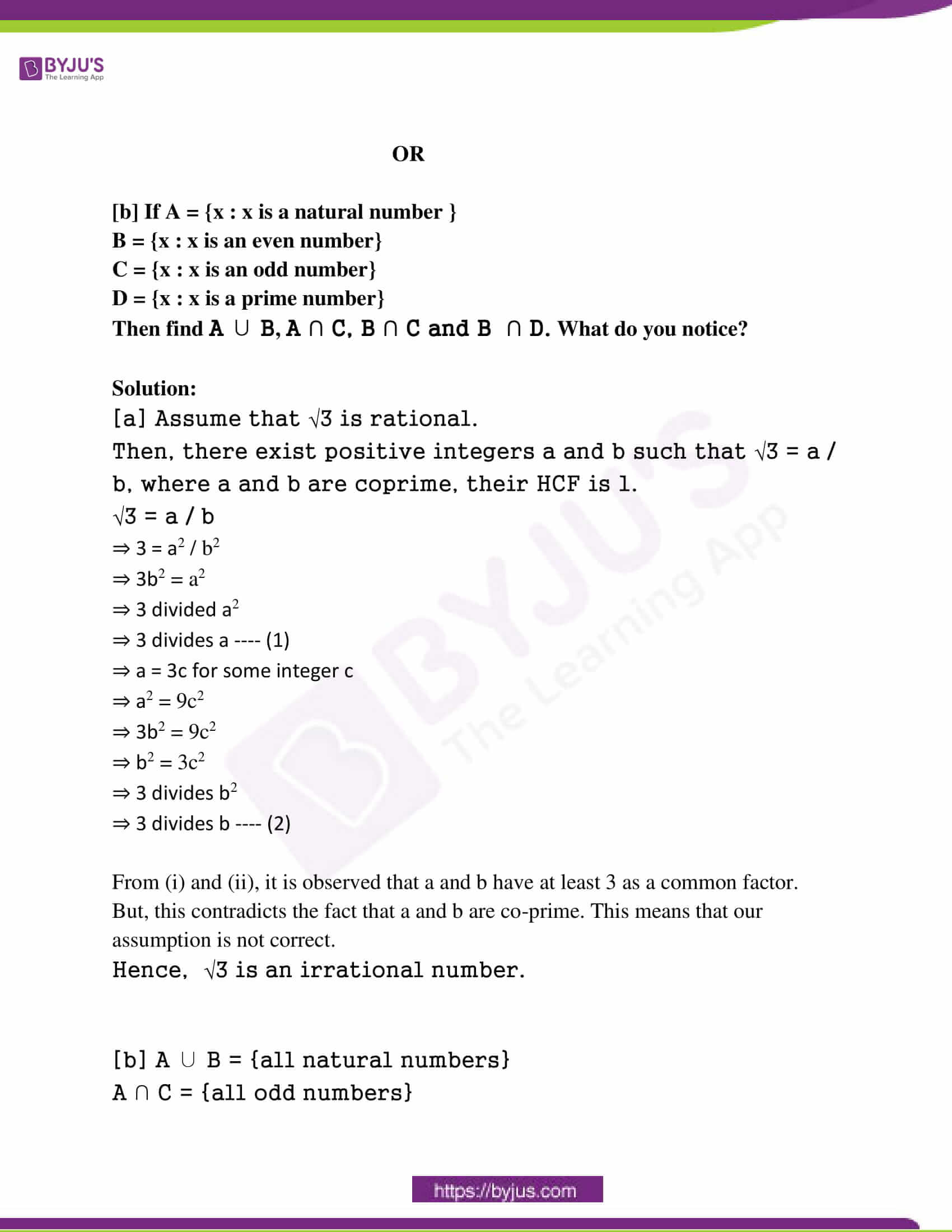
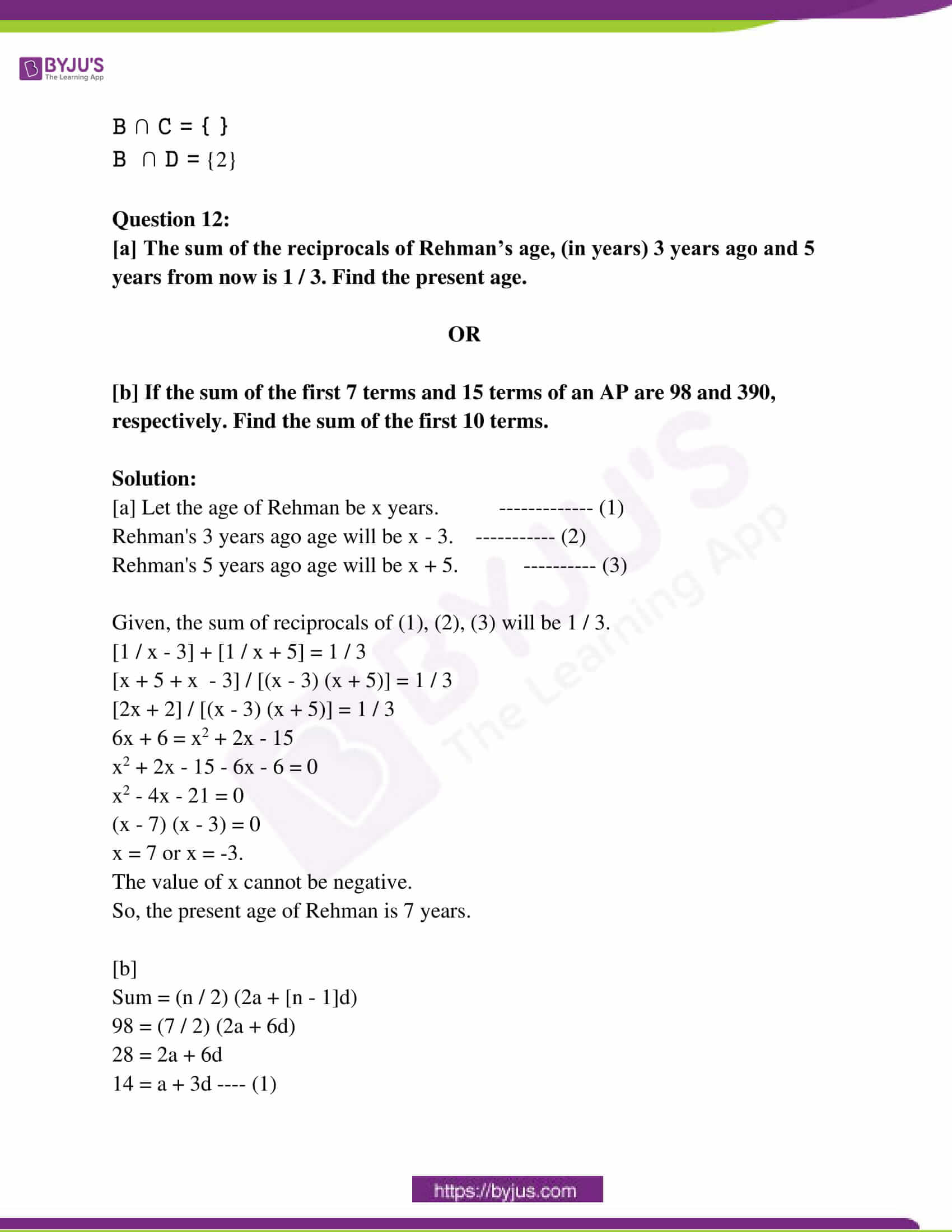
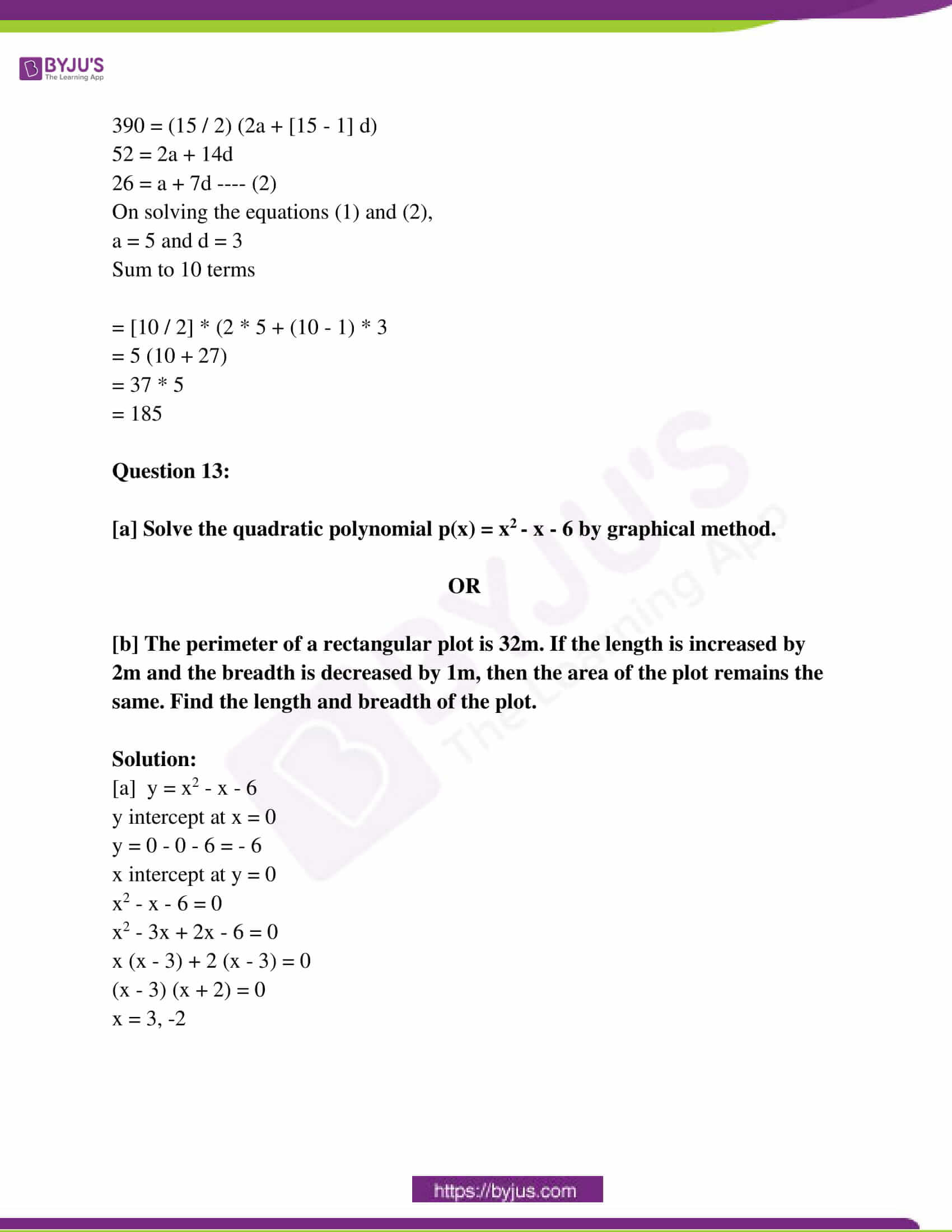
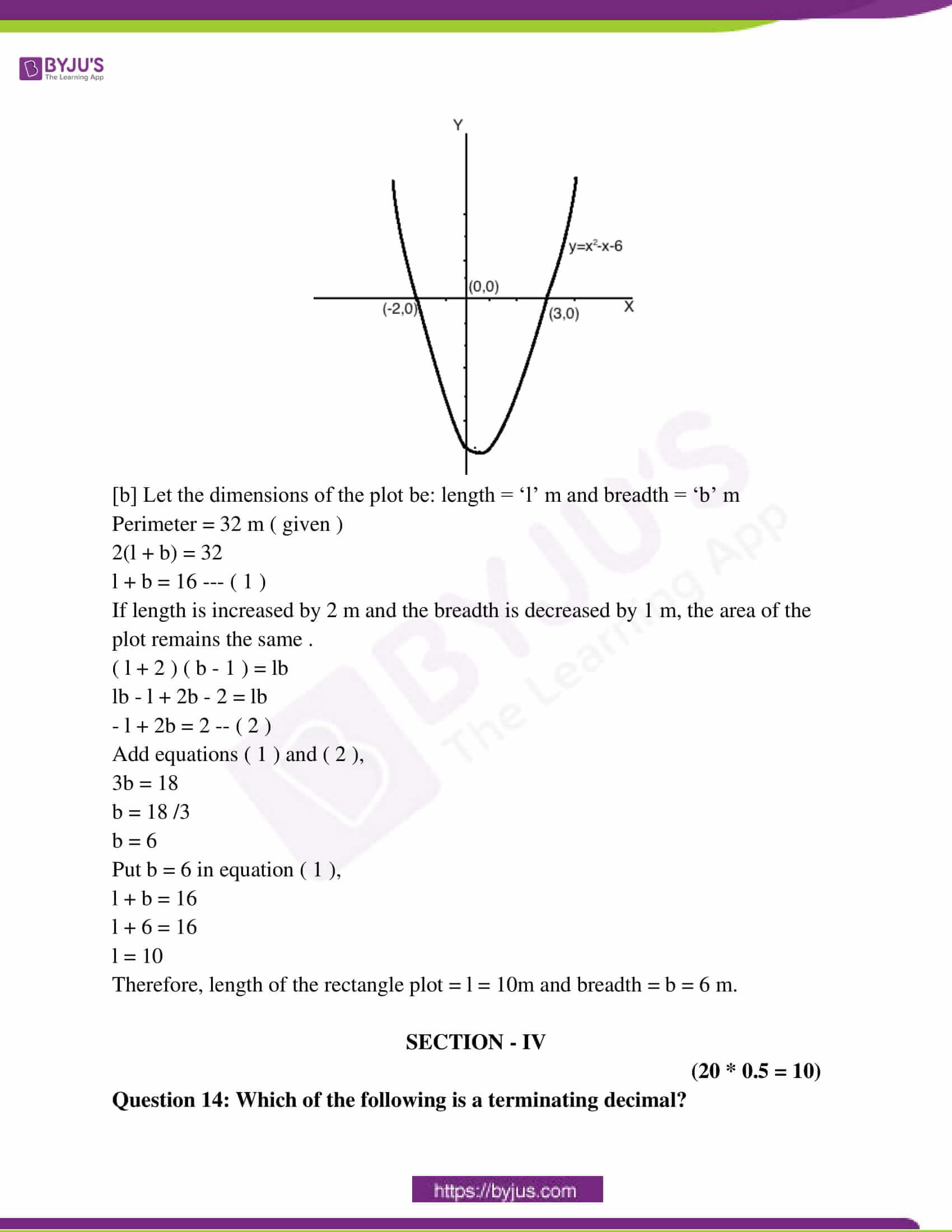


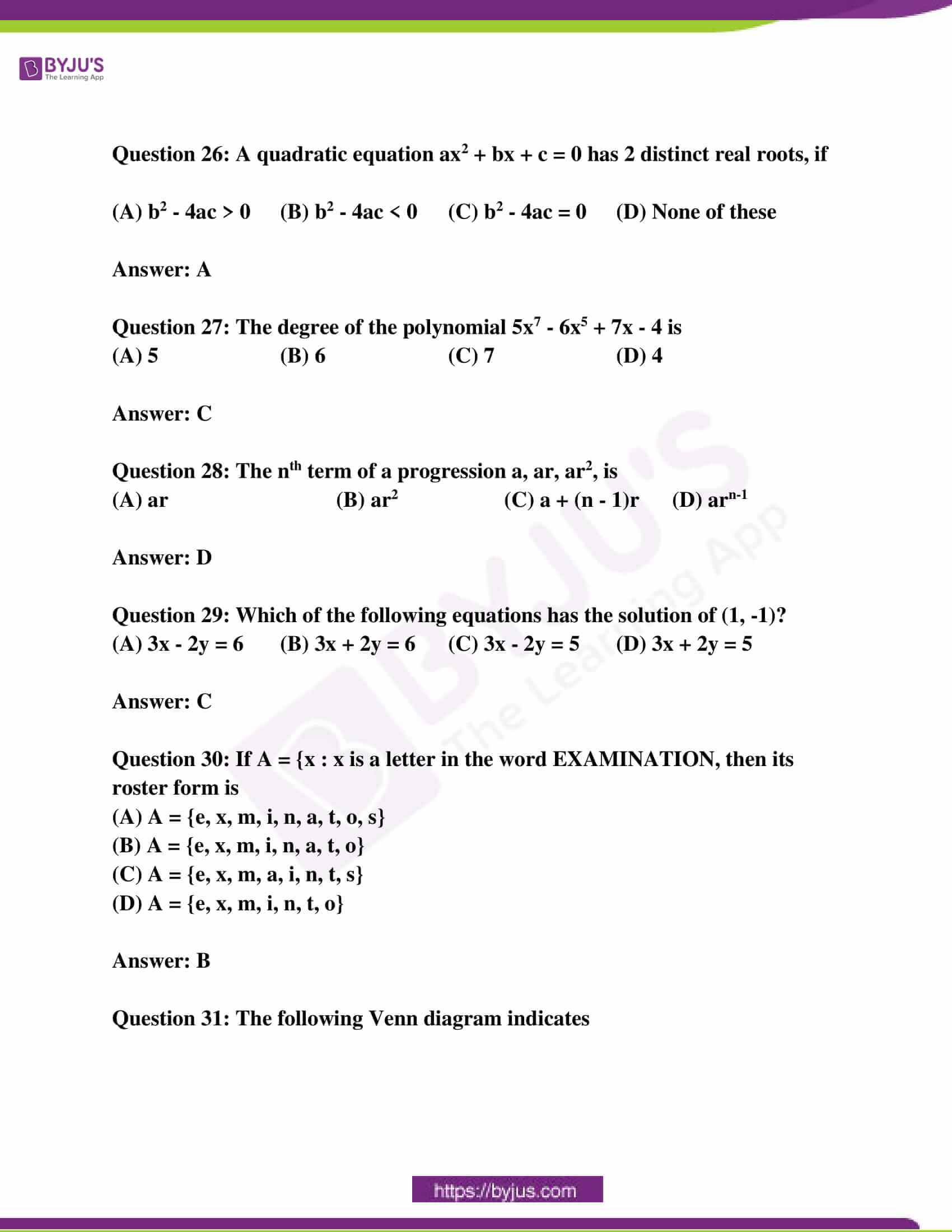
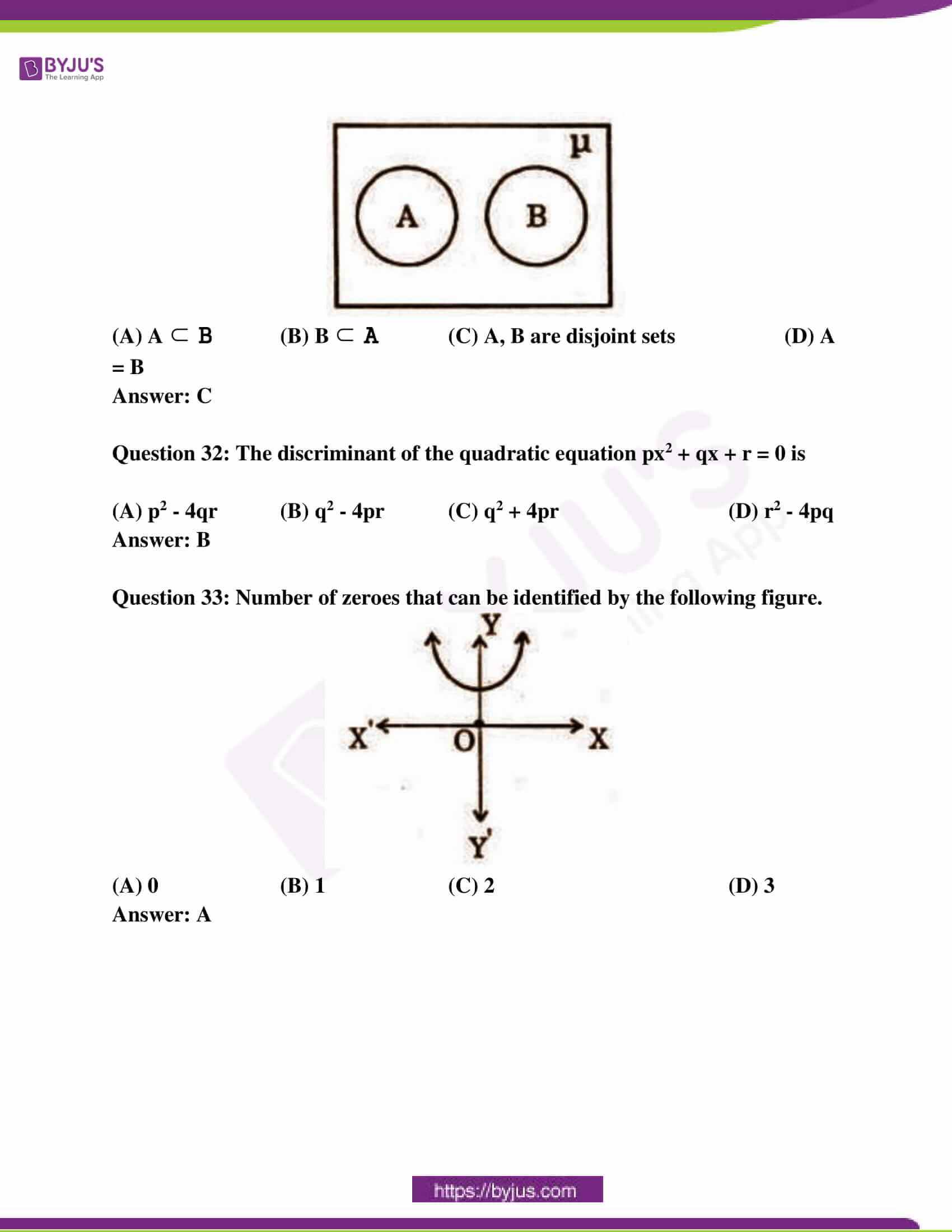
Comments